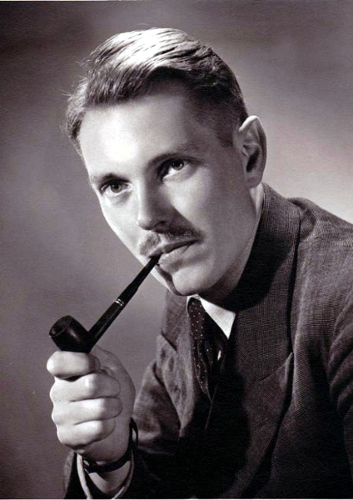 Norman Labrum (Photo courtesy of the Labrum family)
Norman Labrum (Photo courtesy of the Labrum family)
Norman Labrum
Contributed by Wayne Orchiston
Norman Labrum was born in Lubenham, England, in 1921 and grew up in one of the railway houses near Lubenham station, where his father was the signalman. After being educated at Harborough Grammar School, he went on to gain a first class honours degree in physics at Nottingham University and then worked on radar research for the Royal Navy during WWII. In 1946 he moved to Sydney, Australia, after accepting a position in the Commonwealth Scientific and Industrial Research Organisation's Division of Radiophysics.
At Radiophysics, Norman joined Jack Piddington's group, and began investigating solar radio emission at 9,428 MHz in collaboration with Harry Minnett, and they also observed the 1 November 1948 partial solar eclipse.
In 1949 Norman left radio astronomy, transferring to the Cloud Physics group within the Division of Radiophysics, and he only returned to solar radio astronomy in 1957 with the completion of the Chris Cross at Fleurs field station. Using this unique crossed grating interferometer, Norman was able to research solar bursts and limb brightening at 1420 MHz, and he produced a number of papers in collaboration with the visiting Indian radio astronomer, T. Krishnan.
When the 60-ft "Kennedy Dish" was installed near the eastern end of the E-W arm of the Chris Cross Fleurs in November 1960 (as a prelude to its ultimate transfer to Parkes), it was used as a multiplying element with the E-W arm to form the Fleurs Compound Interferometer. Norman then led a Radiophysics team that used this interferometer to investigate the positions and angular sizes of eight of the strongest discrete radio sources.
After the Culgoora Radioheliograph was commissioned in 1968, Norman was one of those who continued to research solar emission at 80 and 160 MHz, and his principal achievement was to join Don McLean in co-editing the book Solar Radiophysics (McLean , D.J., and Labrum, N. (eds.), 1985. Cambridge, Cambridge University Press).
Outside of his work, Norman enjoyed literature, bush-walking, carpentry, bridge and chess, and he once appeared on the TV game show, Sale of the Century. Not long after moving to Sydney Norman met Rosemary, and they were married in 1948. Norman died on June 17, 2011.
![[IAU logo]](iau_wb_thumb.jpg)
![[URSI logo]](URSI-logo-thumb.jpg)
![[Karl Jansky at his antenna]](jansky_photo_02_thumb.jpg)
![[Reber's Wheaton antenna]](Reber_Telescope_Wheaton_thumb.jpg)
![[Dover Heights]](Dover_Heights_02_thumb.jpg)
![[4C telescope]](GB61-195_4C_telescope_thumb.jpg)
![[Ewen and horn antenna]](ewen_horn1s.jpg)
![[Dwingeloo, 1956]](Dwingeloo-1956-thumb.jpg)
![[Jocelyn Bell Burnell and Cambridge antenna used in pulsar discovery]](burnell2_thumb.jpg)
![[Lovell Telescope at Jodrell Bank]](site_1594_0001-500-334-20180316163019-thumb150.jpg)
![[Wilson, Penzias, and Bell Labs horn antenna]](wilson-penzias-horn_thumb.jpg)
![[6-m Millimeter Radio Telescope in Mitaka, Japan]](6m-thumb.jpg)

